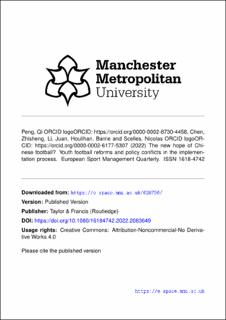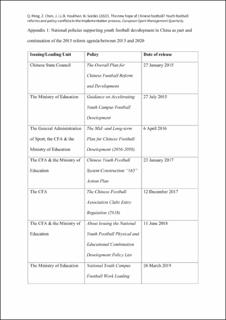| dc.contributor.author | Peng, Qi | |
| dc.contributor.author | Chen, Zhisheng | |
| dc.contributor.author | Li, Juan | |
| dc.contributor.author | Houlihan, Barrie | |
| dc.contributor.author | Scelles, Nicolas | |
| dc.date.accessioned | 2022-11-29T17:54:02Z | |
| dc.date.available | 2022-11-29T17:54:02Z | |
| dc.date.created | 2022-09-14T11:23:21Z | |
| dc.date.issued | 2022 | |
| dc.identifier.citation | European Sport Management Quarterly. 2022, Artikkel 2083649. | en_US |
| dc.identifier.issn | 1618-4742 | |
| dc.identifier.uri | https://hdl.handle.net/11250/3034855 | |
| dc.description | This is an Open Access article distributed under the terms of the Creative Commons Attribution-NonCommercial-NoDerivatives License (http://creativecommons.org/licenses/by-nc-nd/4.0/), which permits non-commercial re-use, distribution, and reproduction in any medium, provided the original work is properly cited, and is not altered, transformed, or built upon in any way. | en_US |
| dc.description.abstract | Research question: This research focuses on the implementation of youth football policies in China following the 2015 national football reform. It asks the question ‘To what extent have contextual and organisational factors facilitated and/or constrained the effective implementation of Chinese youth football policies?’
Research methods: Guided by a critical realist ontology, we conducted 23 semi-structured interviews with key stakeholders involved in the implementation process of the youth football policy including members of the national and local football associations, schools, and professional football clubs.
Results and findings: The findings reveal a number of policy conflicts that restricted an effective implementation of the youth football policies. The main conflict lay in the ambiguous intertwinement of two dominant policy coalitions (i.e. sport and education), which consequently led to confusion and conflicts among key implementers in the three pathways. Other factors such as the continuous mismatch of traditional values and beliefs held by actors towards youth football participation, as well as the emphasis on excellence over participation by some actors are also identified as having potentially inhibited effective implementation.
Implications: This paper contributes to the debate of the positioning of youth sport in an increasingly elite-driven sporting context. It argues that policymakers, implementers, and the overall society, even if they are willing to foster a positive youth sport development, can also generate an adverse effect if they do not work together. | en_US |
| dc.language.iso | eng | en_US |
| dc.subject | Chinese football | en_US |
| dc.subject | implementation | en_US |
| dc.subject | interorganisational relationship | en_US |
| dc.subject | policy conflict | en_US |
| dc.subject | youth sport | en_US |
| dc.title | The new hope of Chinese football?: Youth football reforms and policy conflicts in the implementation process | en_US |
| dc.type | Peer reviewed | en_US |
| dc.type | Journal article | en_US |
| dc.description.version | publishedVersion | en_US |
| dc.rights.holder | © 2022 The Author(s) | en_US |
| dc.source.pagenumber | 23 | en_US |
| dc.source.journal | European Sport Management Quarterly | en_US |
| dc.identifier.doi | 10.1080/16184742.2022.2083649 | |
| dc.identifier.cristin | 2051573 | |
| dc.description.localcode | Institutt for idrett og samfunnsvitenskap / Department of Sport and Social Sciences | en_US |
| dc.source.articlenumber | 2083649 | en_US |
| cristin.ispublished | true | |
| cristin.fulltext | original | |
| cristin.qualitycode | 2 | |

